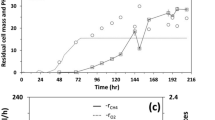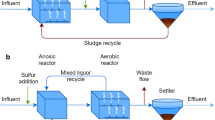Abstract
A pure bacterial culture and a two-membered mixed culture were isolated that degraded trichloroacetic acid if a second, readily metabolizable substrate was present in the growth medium. Previous doubts over the microbial dehalogenation of trichloroacetic acid (TCA) may be due to its inability to act as a sole carbon and energy source. TCA dehalogenation was associated with conventional 2-haloalkanoic acid dehalogenases but oxalate, the putative dehalogenase product, was not detected. CO2 was produced rapidly and concomitantly with Cl− ion release during dehalogenation of TCA. An alternative mechanism is suggested for TCA dehalogenation via an initial decarboxylation reaction. This mechanism predicts that carbon monoxide is a product of TCA decarboxylation and it was significant that one of the organisms isolated,Pseudomonas carboxydohydrogens, was a carboxytroph and a second was an unidentified facultative methylotroph.
Similar content being viewed by others
References
Bradford, M.M. 1976 A rapid and sensitive method for the quantitation of microgram quantities of protein using the principle of protein-dye binding.Annals of Biochemistry 72, 248–254.
Calkins, V.P. 1943 Microdetermination of glycollic and oxalic acids.Annals of Chemistry 15, 762–763.
Daish, P. & Leonard, J.V. 1985 Rapid profiling of plasma organic acids by high performance liquid chromatography.Clinica Chimica Acta 146, 87–91.
Ehrlich, G.G., Goerlitz, D.F., Bourell, J.H., Eisen, G.V. & Godsy, E.M. 1981 Liquid chromatography procedure for fermentation product analysis in the identification of anaerobic bacteria.Applied and Environmental Microbiology 42, 878–885.
Foy, C.L. 1975 The chlorinated aliphatic acids. InHerbicides: Chemistry, Degradation and Mode of Action, eds Kearney, P.C. & Kaufman, D.D., pp. 399–452. New York: Marcel Dekker.
Friedman, T.E. & Haugen, G.E. 1943 Pyruvic acid. II. The determination of ketoacids in blood and urine.Journal of Biological Chemistry 147, 415–442.
Fry, J.C. & Humphrey, N.C.B. 1978 Techniques for the study of bacteria epiphytic on aquatic macrophytes. InTechniques for the Study of Mixed Populations, Society for Applied Bacteriology Technical Series, 11, eds Lovelock, D.W. & Davies, R. pp. 1–29. London: Academic Press.
Hardman, D.J. 1991 Biotransformation of halogenated compounds.Critical Review in Biotechnology 11, 1–40.
Hardman, D.J. & Slater, J.H. 1981 The dehalogenase complement of a soil Pseudomonad grown in closed and open cultures on haloalkanoic acids.Journal of General Microbiology 127, 399–405.
Jensen, H.L. 1960 Decomposition of chloroacetates and chloropropionates by bacteria.Acta Agriculturae Scandinavica 10, 83–103.
Jensen, H.L. 1963 Carbon nutrition of some microorganisms decomposing halogen-substituted aliphatic acids.Acta Agriculturae Scandinavica 13, 404–412.
Kearney, P.C., Kaufman, D.D. & Beall, M.L. 1964 Enzymatic dehalogenation of 2,2-dichloropropionate.Biochemistry and Biophysics Research Communications 14, 29–33.
Klages, U., Krauss, S. & Lingens, F. 1983 2-haloacid dehalogenase from a 4-chlorobenzoate-degradingPseudomonas Species CBS3.Hoppe-Seylers Physiological Chemistry 364, 529–535.
Lignell, R., Heinonen-Transki, H. & Uusi-Kauva, A. 1984 Degradation of trichloroacetic acid (TCA) in soil.Acta Agriculturae Scandinavica 34, 3–8.
March, J. 1977Advanced Organic Chemistry: Reactions, Mechanisms and Structure, 2nd edn, p. 575. New York: McGraw-Hill.
Meyer, O., Lalucat, J. & Schlegel, H.G. 1980Pseudomonas carboxyhydrogens, (Sanjieve and Zavarzin) comb. nov., a monotrichous, non-budding, strictly anaerobic, carbon monoxide-utilising hydrogen bacterium previously assigned toSeliberia.International Journal of Systematic Bacteriology 30, 189–195.
Motosugi, K. & Soda, K. 1983 Microbial degradation of synthetic organochlorine compounds.Experientia 39, 1214–1220.
Motosugi, K., Esaki, N. & Soda, K. 1982 Purification and properties of a new enzyme,DL-2-haloacid dehalogenase, fromPseudomonas oxalaticus.Journal of Bacteriology 150, 522–527.
Omori, T. & Alexander, M. 1978 Bacterial and spontaneous dehalogenation of organic compounds.Applied and Environmental Microbiology 35, 512–516.
Roberts, H.A. 1982 Herbicides and their properties. InWeed Control Handbook—Principles, ed Roberts, H. pp. 106–157. Oxford: Blackwell Scientific.
Senior, E., Bull, A.T. & Slater, J.H. 1976 Enzyme evolution in a microbial community growing on the herbicide Dalapon.Nature 263, 476–479.
Slater, J.H., Lovatt, D., Weightman, A.J., Senior, E. & Bull, A.T. 1979 The growth ofPseudomonas putida on chlorinated aliphatic acids and its dehalogenating activity.Journal of General Microbiology 114, 125–136.
Sykes, P. 1981A Guidebook to Mechanisms in Organic Chemistry. 5th edn. Harlow, UK: Longman.
Wagner, W.M. 1959 A new synthesis of dichlorocarbene.Proceedings of the Chemical Society,August, 229.
Weightman, A.J. & Slater, J.H. 1980 Selection ofPseudomonas putida strains with elevated dehalogenase activity by continuous culture growth on chlorinated alkanoic acids.Journal of General Microbiology 121, 187–193.
Weightman, A.J., Weightman, A.L. & Slater, J.H. 1982 Stereospecificity of 2-monochloropropionate dehalogenation by two dehalogenases ofPseudomonas putida PP3; evidence for two different dehalogenating mechanisms.Journal of General Microbiology 128, 1755–1762.
Author information
Authors and Affiliations
Rights and permissions
About this article
Cite this article
Weightman, A.L., Weightman, A.J. & Slater, J.H. Microbial dehalogenation of trichloroacetic acid. World J Microbiol Biotechnol 8, 512–518 (1992). https://doi.org/10.1007/BF01201951
Received:
Accepted:
Issue Date:
DOI: https://doi.org/10.1007/BF01201951




